Wednesday, November 28, 2007
Beltane Video
Monday, November 26, 2007
For Sale

Beltane is for sale because we bought a bigger, if older, Hallberg-Rassy in September. Litha, the new boat, is in Sidney, B.C. this winter getting fixed up for a summer season in the northwest next year.
If your RSS feed date for this blog is stuck on 1/1/07, maybe you should click the "Subscribe to" button at the bottom of the blog (or right here) to get the updated feed. BUT, before you click to subscribe:
Microsoft Internet Explorer 6.0 attempts to download links to site feeds, rather than display them in the browser. You can right-click the link to copy the location into your feed reader.
When Google bought Blogger earlier this year, they changed from RSS to Atom. I think that caused the date problem. The download issue -- who knows! You might want to check that this new feed works before deleting the old one.
Researching this issue reminds me of one of the reasons I left my old job.
Thursday, April 26, 2007
Journey's End

We explored a few new anchorages on Baja and wound up at Punta Chivato to wait for the right weather to cross back to San Carlos, near Guaymas (5 hours from the Arizona border) where the journey began. We departed April 22 at 7 a.m. with lumpy seas, but they eased and the wind built and we sailed for four hours before having to turn the engine on again for the rest of the trip. We arrived in San Carlos at 7 p.m. with several layers of clothes on (it was chilly) and anchored. Ahhhh -- it's good to be back.
Got a list of things to do to put the boat up for the summer, so we'll be running around for a week or so. But our truck is here and it's good to have our own wheels again as we start transitioning back to life on terra firma and eventually reintegrate into U.S. culture. See ya next winter!
Saturday, April 21, 2007
Spring in the Sea of Cortez

We left La Paz under a brisk wind March 31. Robert (and Dusty) sailed in his boat, Destiny, with us to Partida and San Francisco Islands and that was great fun since we had dinner together each night and hiked the trails together on both islands. He even joined our daily Scrabble game a few times. We snapped photos of each other sailing as we left La Paz and we got to use our spinnakers for a while on the sail to San Francisco.
After Robert returned to La Paz, we went a little further north and ran into friends Alex and Edith and Andy and Deb at Evaristo. Steve worked on Seagull engine and battery issues. Then we headed up to El Gato, 30 miles north.
As in all the other anchorages we’ve visited, fishing is a way of life here and the families that live on the rocky Baja coast depend on it because little else is available. We see the men out in their panga fishing boats collecting or casting nets and diving along the reefs. Some of these families also keep goats to make cheese from their milk.

Some high points from this section of the adventure: hiding out in a safe anchorage listening to 30-40 knots of wind howl all night, getting the dinghy outboard working again, beach walks, desert hikes, getting the anchor stuck (temporarily).
Friday, April 20, 2007
The Pause that Refreshes

We stayed in La Paz almost a month, learning our way around more, finding a better grocery store and more restaurants. We even took in a movie or two. Our friend Robert drove us and his Australian Shepherd, Dusty, in his Prius to Todos Santos on the Pacific coast one day and on another day to a nearby beach, Tecolote. Dusty likes to play Frisbee on the beach and I really enjoyed having a dog around. I also reconnected with my basset hound friend who lives near the marina.
Elixir

I caught a cold that turned into something like a sinus infection. One of the taxi drivers that hangs out near the marina asked "Como estas?" I replied, "Estoy resfriado" (I have a cold). He said "Tomas tequila" (drink tequila). I laughed thinking he was kidding, but after my next margarita, my sinus infection cleared up.
Thursday, March 08, 2007
Slow Boat to La Paz

We left Mazatlan Tuesday, March 6 and had rough seas in the shallow water along the coast to the north. The next day, we were in deeper and calmer water and had a great sail all day. There was nothing to see though, no diving birds or flying fish or whales, only about 5 shrimp boats the whole way, and having an almost full moon made the night watches better. We got into Marina de La Paz Thursday morning after navigating the unmarked San Lorenzo Channel, which this time was rather calm. It took as long to go from Mazatlan to La Paz as it did to go from Baja to Puerto Vallarta. It was fewer miles but we were headed into the wind. All in all, a good trip and it's great to be back in Baja.
Wednesday, February 28, 2007
PV to Mazatlan

Chac-aaaaaaahhh-la
We loved Chacala. It's a small bay, about 1-1/2 miles wide, with a beautiful wrap-around beach, good dinghy landing, beach palapas, easy swim to shore, nice tourist resort, wonderful. We reprovisioned some and left 2 days later for San Blas.
Beltane of San Blas
The trip to San Blas turned out to be perfect. Henry Wadsworth Longfellow wrote the "The Bells of San Blas" in 1882 about the forgotten friars who established a mission and introduced Catholicism there. We had a slow, pleasant sail across shallow (10-12m) Mantechan Bay, which has hosted international surfing contests, to our anchorage on the north shore near San Blas with about 7 other boats. We were playing Scrabble in the cockpit when the noseums came out at dusk (which we'd been warned about), so we headed inside and left in the morning for Isla Isabella.
Isla Isabella

We had a rocky ride all day to this volcanic island set aside as a Parque Nacional due to its bird rookery. We were so glad to anchor and get out of the wind and rough seas. The next day, we hiked the trail through the rookery. The frigate and boobies (red-, yellow-, and blue-footed varieties) let us come within a foot of them, their nestlings, and eggs. We also saw many iguanas, seagulls, and other types of seabird.
It’s pretty special to eat dinner in the cockpit, swaying at anchor, volcanic cliffs around you, live with the sound of seabirds, and the clear, green sea just a few feet away.
Mazatlan
We left Isla Isabella at 4:00 in the afternoon, February 27, arrived at Mazatlan at 9:00 the next morning after 3 hours of sailing and the rest motoring on calm ses, and docked in Marina Mazatlan. The sky scrapers are quite a change from the wildness of Isabella. We'll wait for a weather window here before crossing to La Paz to meet our friends, Alex and Edith.
Sunday, February 18, 2007
Heading North

We left Barra Navidad the Tuesday after the Super Bowl, after sending faxes, asking U.S. bound boaters to carry mail for us, and a visit to the doctor because Steve's back started to act up. We spent the next 10 days 10 miles north in Tenacatita Bay, where we'd visited on the way down. After three days of high north wind died, we headed north again to Chemala Bay. The autopilot stopped coming on at Barra, so the trip back to La Paz at least will be all hands-on steering. The 30 miles to Chemala went quickly due to the fact that we were motoring and we had a 1.5 knot current with us, which is surprising because it seems like the current would go south here.
After a night in Chemala (20 knot winds at anchor in the afternoon), we motored the 60 miles (minus 45 minutes of sailing cut short because the captain was sick and wanted to get to anchor) to Ipala, continuing to retrace our steps from last month. There is 30 miles of uninterrupted golden sand, uninhabited beach here. Ipala is just a small cove where the locals are farming seafood, so there is little anchor room and since about six boats were already there, we were left in an open spot prone to swell and we rolled all night.
Close Encounters of the Sea Life Kind
On the way to Ipala, we saw about a dozen turtles and four snakes. Also, at anchor in Ipala about 8:00, I heard noises outside and went out to hear something spouting right next to the boat and to see swirling water bright with bioluminescence. We heard a bump against the boat and Steve went out and saw a whale surface right next to the boat. Apparently it was chasing food around the boat. It bumped us and spouted a couple more times before finally moving on. Kinda scarey.
Corrientes, Take Two
We left Ipala at 7:00 and rounded the cape about two hours later, plunging into 8-9' seas, but little wind, and apparently with the current still in our favor. I, No.1, must state that I was all alone behind wheel since Steve was not feeling well and was in bed until we hit the biggest wave which brought him up to see what was happening. Soon, the sea calmed and we entered Banderas Bay. The wind was from the west, so we cut the engine, pulled out the sail, and Steve set the wind vane to steer us. We had a great sail to our anchorage at La Cruz; however, the wind built and we saw 30 knots (gale starts at 35 knots) just before our anchorage. An "exciting" sail.
Friday, January 26, 2007
Bahia Navidad
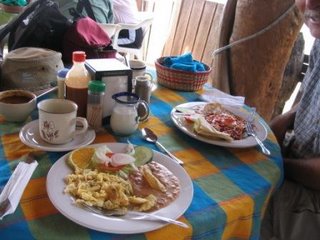
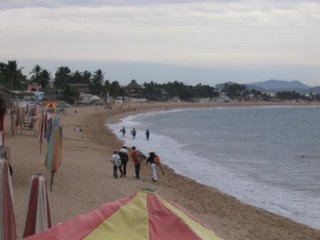
We left Bahia Tenacatita Monday, Jan. 22, in 10-15k NW winds (finally) and did a chicken jybe in 6' seas to head south. It went off without a hitch.
We entered Bahia Navidad (20 miles north of Manzanillo) less than three hours later, saw the channel to Barra Navidad, but turned left and anchored in the beach harbor of Melaque, situated in the same bay. The bay is surrounded by beach with waves starting small in Melaque and growing to giants by the end at Barra (so named because it is built on a sandbar). Hotels (bungalows) and palapa cafes cater to Canadians and other norte Americanos. Street dogs bathe in the sun on the beach with everyone else. The cerveza, huevos rancheros, and view are mui bueno.
Mexicans vacation here and the kids have so much fun playing on the beach and in the waves. There are tables to sit at and strolling native indians sell their crafts or others sell pineapple drinks and mango or bread treats.
We met up with Howard and Gail and their dog Britta (Portuguese Water Dog who climbed our ladder to board Beltane) on Anu, who Steve met last year, and they shared a bottle of champagne with us for my birthday on the 25th. Thanks for the native handcrafted bowl. Steve liked it so much he bought 5 plates today from the same lady who painted that one.
Bob at Hogin Sails stitched up our canvas dodger. Now we just have to navigate the narrow channel to the fuel dock before heading north again.
Tuesday, January 23, 2007
Jungle Heat, Tropical Eats
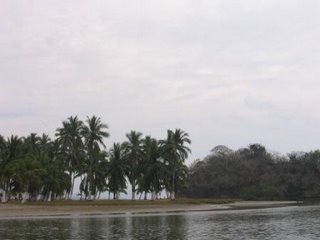
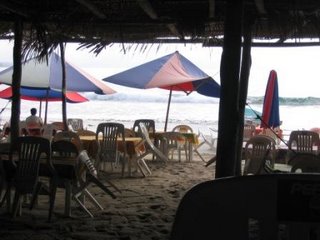
South of Banderas Bay, they said we'd have light winds. But we expected it would still be from the north, the same as the prevailing winds in the Sea of Cortez, not from the south, the direction we are heading,which is what we found to begin with. Anyway, we anchored at Chemala Bay, about 50 miles south, for four days with about 12 other boats. This four mile bay was surrounded by a nice beach that is frequented by locals on the weekends. Then, we headed into the wind and went south 30 miles to Tenacatita Bay. More gorgeous beach with beachfront palapa cafes. It all looks great, but with humidity in the 90 percent range, it is always hazy and quite a change from dry Baja. At least the temperatures are in the 70s. I can't imagine this place in summer.
At Chemala, we had great pina coladas at one of the palapas and ordered shrimp cocktail. It arrived in a parfait glass, hot, with shrimp (camarrones), octopus (pulpo)), scallops, and carolones (sea snail). Steve said, "don't look at it; just eat it." Then, we went to the market.
This involved a walk down the beach and then up a block or two to the road and shopette. It's a typical Mexican mini-market, but they had no meat so we asked if there was a carniceria close by where we could buy chicken. The lady said, "can you wait 20 minutes?" Yes, so we sat outside and Steve conversed with the two locals about boats, fishing, etc. Their dog enjoyed the ice cream I dropped on the ground and the sausage Steve bought and fed to him. He didn't have a name, just "Perro." About an hour later, a chicken arrived, warm, right out of someone's backyard, but thankfully, dead, defeathered, and cleaned. When we cooked and ate it later, we discovered it was a rooster And with our preparation, "coc au vin" it was not. It was more like chewing calamari with chicken flavor.
Cabo Corrientes
All this happened in one minute as we were anchoring: Steve went forward to drop the anchor; I saw his bloody footprints; he didn't know his foot was cut; I fetched a bucket of seawater and dumped it on the deck over the footprints, but failed to see that the portlight was open over the nav station; Steve dropped the anchor and then saw his bloody trail; I went below to find the laptop keyboard wet with the seawater I'd pourerd to douse the blood. How can so much can go wrong in so little time? But, the laptop's touchpad seems to be the only thing affected by the seawater and we have a mouse to use in its place, so there's a work-around. Steve had only cut his toe slightly, and most of the blood came out of the teak deck.
Tuesday, January 09, 2007
Puerto Vallarta 1/5-9/07
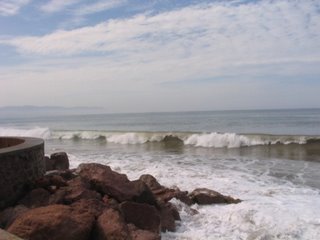
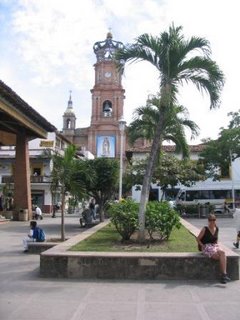
Humid, hazy, big Bay of Banderas. We are anchored off La Cruz Huanacaxtle where, to go ashore, we have to beach our dinghy on a small, rocky beach in murky water that is suspiciously close to the water treatment plant in a man-made harbor that is being dredged. Once we got past that, we found expensive Gringo houses across from Mexican hovels on dirt streets with dogs sleeping here and there. Then we came to the town proper and found a cool, shady French cafe, Hikura, that serves sandwiches, quiche, and omelets, with a great salad.
We took the bus (that runs frequently, but by a mad driver) to Puerto Vallarta and found a nice old town section with huge waves breaking along the waterfront. Lots of norte americanos shopping along the streets. Also, steep cobblestone streets leading to narrow alleys with nice houses above it all.
Cap'n has now fixed the head problem and we plan to leave this week for Chemala Bay, 100 miles south, then to Careyes and Barra Navidad before heading north again (against the wind).
Saturday, January 06, 2007
Leaving La Paz
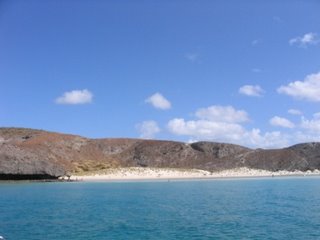
We left La Paz Dec. 30 and anchored at Ballandra (balanced rock) close by, a lovely beach with aquamarine water, but it was very rolly due to the day's north wind.
Dec. 31 -We knew the wind would blow 15-20 today, but didn't expect the Lorenzo Channel to be unmarked. One hour after leaving Ballandra we had 15-26 knot winds in Lorenzo Channel and 6 foot seas. We never saw the channel markers but we were able to follow the path of an approaching ferry. The channel is a few miles wide with reefs on either side, so the navigable part is only 1 mile wide, and shallow (15m). Apparently, Hurricane John destroyed the markers and they haven't been fixed. Since this is Mexico, they may never be fiixed. After getting sprayed with white water on the dodger, we blew down the coast to Muertos on 10-20k winds. This was an excellent test for the rudder repair, but the steering works great with no leakage. It's always an adventure with Steve.
Happy New Year – Hello Puerto Vallarta
We met up with John, Dagmar, and Alex (and their 2 dogs) on Pavon in Muertos and toasted the new year with beers. It was around this time that we discovered the head's holding tank wouldn't empty. We left for Frailles on Jan.1 and snorkeled the Pulmo reef on Jan 2. It wasn't as good as we expected, but the beach and water, and the weather, was lovely. Thanks for the ride back by Michael Ambrose and Linda.
Jan. 3- we set sail for Puerto Vallarta when the weatherman called for 10-20 north winds. It was an excellent crossing (2 days exactly), if you don’t count the bumpy ride due to waves hitting the port stern and rolling us like a roller coaster the second day. We saw only four boats the whole trip and sailed all but the last 10 hours.
Jan. 5 – anchored in Banderas Bay, Puerto Vallarta, actually La Cruz Huanacaxtle which is just to the north in the bay of the formal town of PV. It’s summertime again, and humid. But we are glad to be here. www.puertovallarta.net/map/index.php
Fixed, Deployed, Tested
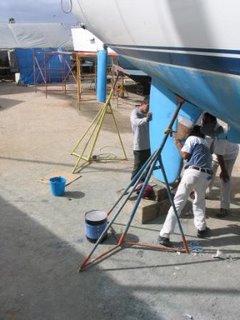
In my old job, it would have been "fixed, tested, and deployed," but in the world of oceans and yachts, when you have to put the boat in the water to test, it's a little different.
Cruising = Boat Repair in Exotic Locations
We were hauled out on Dec. 26 by the big travel lift at the Palmar yard in La Paz and all went well with that, but then we found that the rudder bearing wouldn't budge. Dec. 27, Robert drove us in his Prius to a ferreteria where we bought a giant $100 monkey wrench and Steve removed the bearing, then found he couldn't easily remove the seal because its surface was flush and there was nothing to grab to remove it. So, the yard guys removed the rudder shaft by chipping off fiberglass and then sanding to the brass plate, then found that one of the bolts wouldn't budge and had to drill it out. Once the rudder shaft was out, we could see that it was pitted where the seal had been. But Steve was able to remove the seals and replace them. All this with the limited help of technical drawings and instructions via email (delayed due to the time difference) from Hallberg-Rassy in Sweden. Their instruction to "draw out the simmer seals" didn’t mention how to do it. Beltane was back in el agua Dec. 29.
